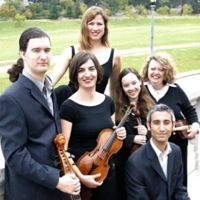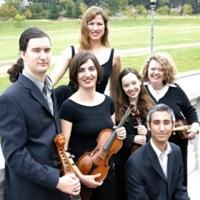
La Monica (violinists Tekla Cunningham and Susan Feldman, violist Ondine Young, cellist/gambist William Skeen, keyboardist Avi Stein, and soprano Phoebe Jevtovic), now a decade old and a familiar contributor to the SFEMS season roster, has hitherto concentrated most of its attention on Italian music of a generation or two earlier than this. But what the unwary might guess to be a large stylistic leap turns out, in this cunningly chosen program, to be next to no distance at all. Certainly anyone who vaguely thought of German music before Bach as a dry thicket of learned counterpoint would have been both surprised and delighted by the selection that La Monica presented Saturday night at St. John’s Presbyterian Church in Berkeley.
The tone was set by the opening work, Dietrich Buxtehude’s Quaemadmodum desiderat cervus (As the hart thirsts), a setting of Psalm 42 for soprano and two violins over a jaunty ground bass that might almost belong to the Italy of Monteverdi’s time. The same composer’s Herr, wenn ich nur dich hab (Lord, if only I have You), for the same forces, proves to be another ground-bass piece, limpid and serene. And the jubilant program-ending setting of Wachet auf, ruf uns die Stimme (Wake up, the voice calls us) by Franz Tunder was full of the eager expectancy of the text.
Elsewhere among the vocal music, pieces of a graver tone were performed. Christoph Bernhard’s Aus der Tiefe ruf’ ich, Herr, zu dir (Out of the depths I call to you, O Lord), which lent its name to the concert, illustrates its opening line with a great ascent from the bottom of the singer’s range to the top. The ensuing music, wide in emotional as well as literal compass, is full of dramatic effects. (Here there are ground-bass sections too, both of them illustrating references to “waiting” in the text; I particularly liked the second of them, where the ground keeps turning back on itself rather than cadencing, until finally it reaches a point of rest.) Tunder’s Ach Herr, lass deine lieben Engelein (O Lord, let your dear little angels) is a funeral piece, quiet and pensive.
Memorable Leave-Taking
More remarkable, and for me the discovery of the evening, was another memorial piece, an extraordinary tribute by Buxtehude to his departed father. The Fried- und Freudenreiche Hinfahrt (Peaceful and joyful leave-taking) contains two parts. One is a setting of the Lutheran chorale “Mit Fried und Freud ich fahr dahin” (With peace and joy I go forth) in four-part invertible counterpoint — that is, the counterpoint “works” whichever line is uppermost, and indeed even if each line is made to go up where the original goes down, and vice versa. La Monica performed the four versions — the original with the tune in the top and then the bottom voice, and the “flipped” version with tune in top and then bottom — using the string quartet alone. It’s refined, remote music whose contrapuntal constraints make the harmonic motion occasionally difficult to follow.The second part of the work is a “Klag-Lied” (lament) to what is likely the composer’s own words. Here, organ doubled the strings, who pulsed their accompaniment as though imitating a tremulant organ stop. It’s a piece of harrowing emotional directness, the vocal line starkly simple and repeated for each strophe, the accompaniment somber and dark. I know few musical tributes that combine such restricted means with such power. Thanks to La Monica for bringing it to us.
Interspersed among the vocal items were a few works for the instruments alone. Two sonatas by Johann Rosenmüller, one each in three and in four parts, were typical of him: strings of brief, connected movements, the fast ones animated and intricate, the slow often tinged with a melancholy chromaticism. A sonata for two violins and continuo by Philipp Heinrich Erlebach proved to be a graceful dance suite almost in the mode of a Corelli chamber sonata; its high point was yet another ground-bass movement, a chaconne whose stepwise-descending bass, in a delightful quirk, repeated every seven bars. (This work also featured scordatura — a nonstandard tuning — for the first violin, though the use Erlebach made of it was almost inaudibly subtle.)
La Monica’s performances were idiomatic and thoughtful. Jevtovic has a clear, sweet voice that at its best (as it was Saturday in the Buxtehude “Klag-Lied”) commands great expressive power. She’s not always ideally secure in pitch, though. The actual slips, mainly flatward, were not especially large or blatant, but they were numerous; after a while I found myself listening in constant low-level apprehension. I could wish, too, for greater care with words (they were too often lost, especially in the high register) and for neater coloratura. But where the music lay well for her, her voice spoke with a simple directness that was affecting, and she shaped her lines with skill and understanding.
Much the same could be said of the instrumental playing, which was deft, intelligent, and well-balanced. It was also, by the standards that have lately become common in this music, a shade reserved; I can imagine a bit more dust being kicked up in some of the sonatas. To be fair, though, the opening and closing Prestos of Rosenmüller’s Sonata IV scampered as nimbly as anyone could reasonably want them to.
The continuo team of Stein (on organ and harpsichord) and Skeen (viola da gamba and cello) was a great asset, Stein elaborating the bass line with panache and not a little rhythmic wit, Skeen adding punctuation and bite. On his own in a blustery Prelude by Nicolaus Bruhns (played, like the Buxtehude “Klag-Lied” after it, on St. Johns’ own full-scale organ rather than the chamber organ used elsewhere in the recital), Stein was less convincing. The many changes of registration seemed overfidgety, and in one section late in the piece his rhythmic displacements were so numerous and so large that it became hard to hear the underlying meter.

